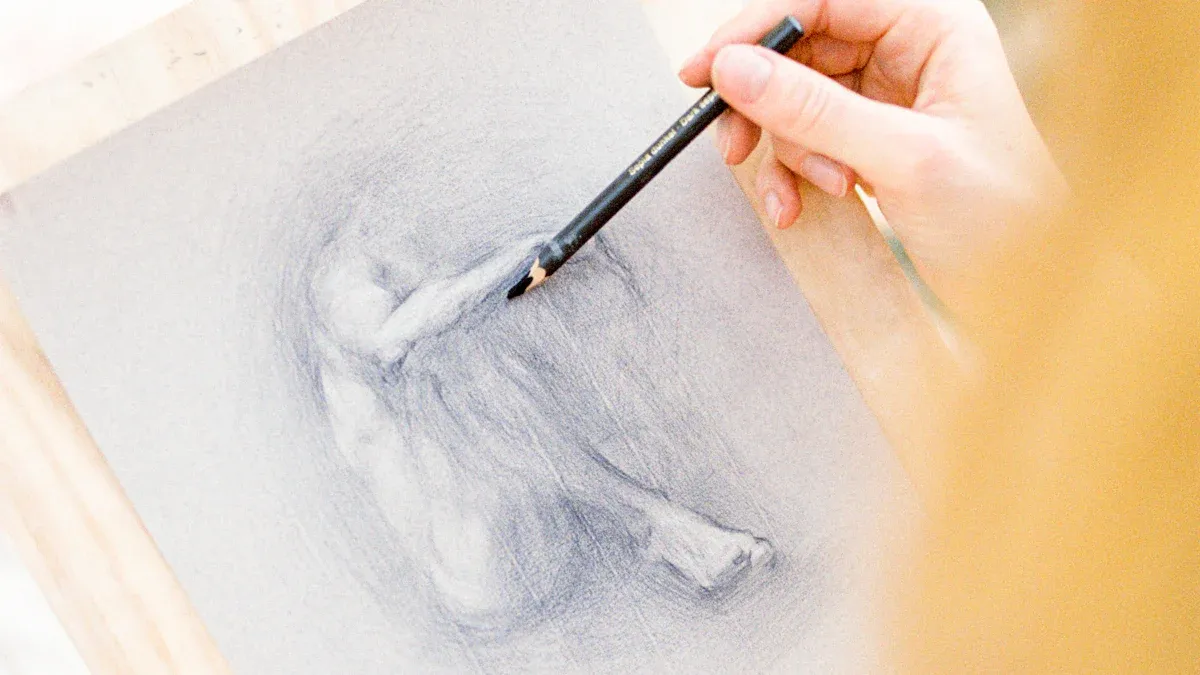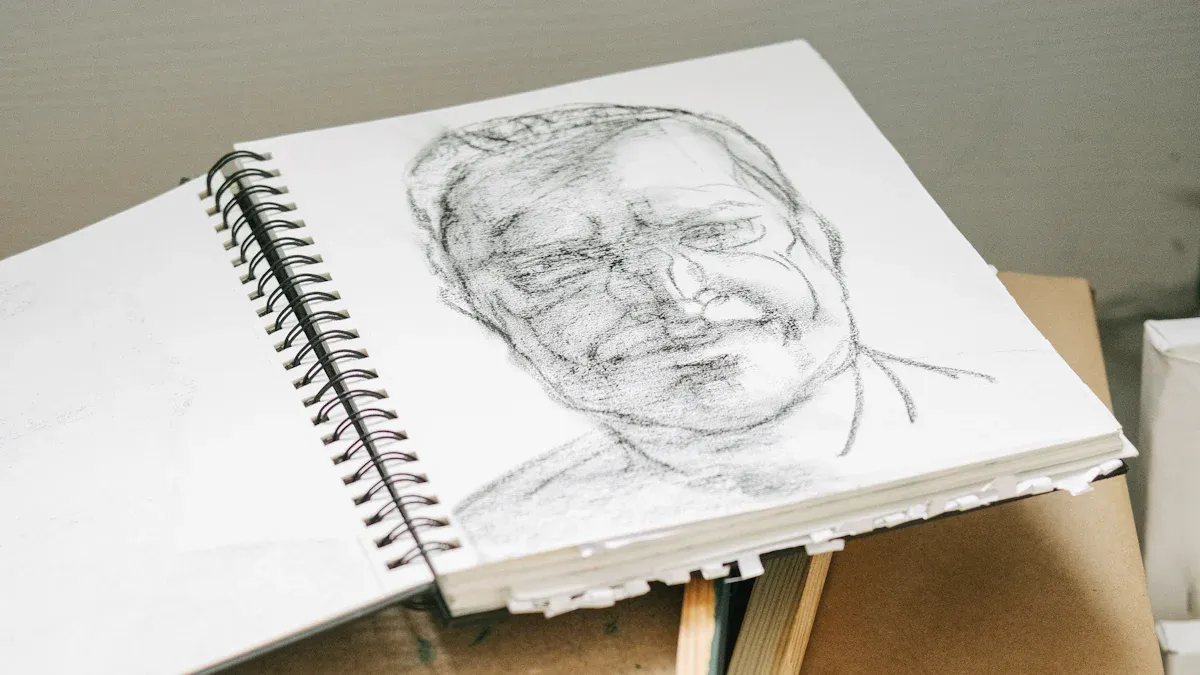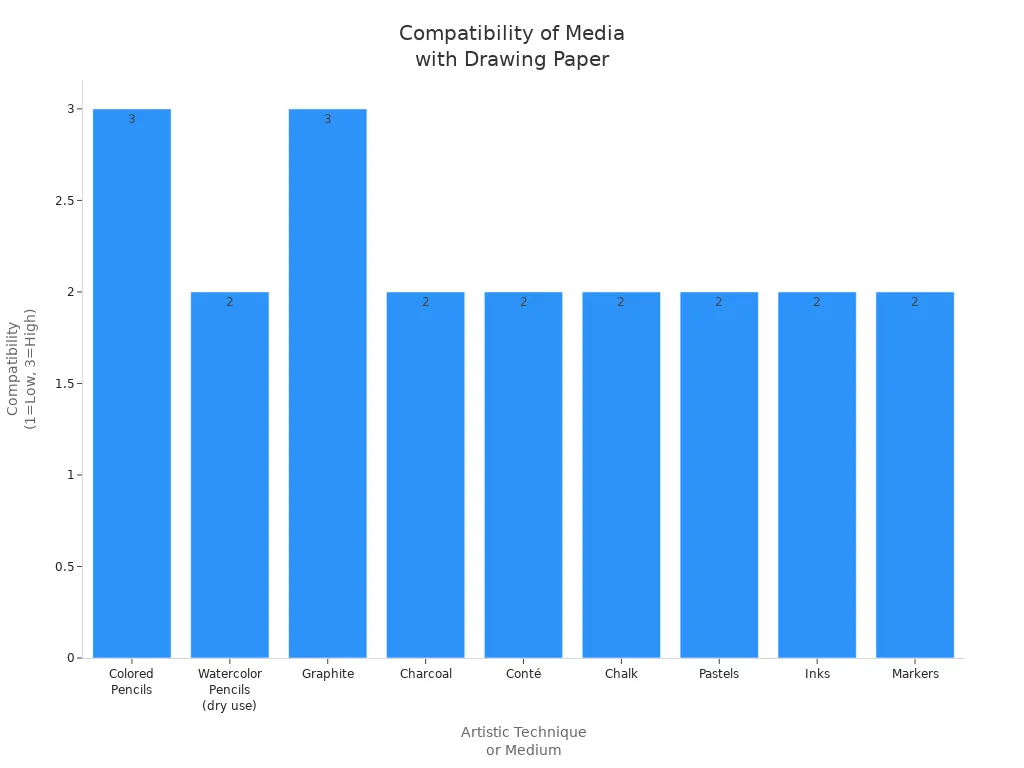- All
- Product Name
- Product Keyword
- Product Model
- Product Summary
- Product Description
- Multi Field Search
English
Views: 0 Author: Site Editor Publish Time: 2025-07-08 Origin: Site











Sketch paper is thin and cheap. It works well for practice with pencils and charcoal. Drawing paper is thicker and stronger. It is best for finished art that needs to last. It can handle many types of art tools. Use sketch paper for quick drawings and trying new ideas. Use drawing paper for detailed art you want to keep. Pick the right paper for your art tools. This helps your art look good. Store and frame your art to keep it safe. Try different papers to see what you like. This helps your art look its best.

When you pick up sketch paper, you notice it feels light and flexible. Most brands make it between 100 gsm and 200 gsm. This weight gives you enough strength for drawing but keeps the paper easy to carry. The surface has a slight tooth, so your pencil or charcoal grips the page without feeling rough. You can erase and layer your lines without tearing the sheet. Lighter sketching paper works great for travel or quick studies. Heavier sheets stay flat and handle more erasing.
You reach for sketch paper when you want to practice, doodle, or plan out ideas. It shines during warm-up exercises, figure drawing, and quick studies. Most artists use it for dry media. Here are some popular choices:
Graphite pencils
Charcoal sticks
Colored pencils
White charcoal pencils
Carbon pencils
Some brands, like Fabriano and Strathmore, design sketching paper for both beginners and pros. You can use it for thumbnail sketches, travel journals, or even classroom projects. If you want to try mixed media, some pads support light washes or markers, but most sketch paper works best for dry tools.
You get a lot of value from sketch paper. It costs less than many other art papers, so you can fill up pages without worrying about price. Take a look at how it compares:
Paper Type | Price Range (USD) | Notes |
|---|---|---|
Sketch Paper | $1.99 - $18.99 | Wide range, fits most budgets |
Charcoal Pads | $4.99 | Good for charcoal, fewer sheets |
Bristol Pads | $6.31 - $8.19 | Smoother, more expensive |
Mixed Media Pads | $3.99 - $5.89 | Handles more media, mid-range price |
Marker Pads | $5.00 | For markers, usually more sheets |
Tip: If you want to experiment or make mistakes, sketching paper lets you do that without stress.
Pros:
Affordable for daily use
Lightweight and portable
Great for practice and studies
Works well with dry media
Cons:
Not ideal for finished artwork
Can wrinkle with too much erasing or wet media
Thinner sheets may tear if you press hard
You can see why sketch paper is a favorite for learning and exploring new ideas. It gives you freedom to create without worrying about cost or mistakes.

When you pick up drawing paper, you feel the difference right away. It feels thicker and stronger than sketch paper. Most brands make it from 70 lbs up to 250 gsm, so it can handle more pressure and erasing. You see a range of textures, from smooth to rough. Smooth paper lets you draw tiny details. Textured paper grabs more graphite or pastel, so you get darker lines and rich shading.
You get more durability from drawing paper. Acid-free and archival options keep your art safe from yellowing or fading. Some of the best drawing paper even uses cotton for extra strength.
Drawing paper works great for finished artwork. You can use it for many techniques and tools. It handles more than just pencils. Here are some favorites:
Graphite pencils for fine lines and shading
Charcoal pencils for bold, dark marks
Colored pencils for bright, layered color
Markers for details and coloring
Pastels and chalk for soft, blendable effects
Inks for illustrations and calligraphy

You can try different types of drawing paper to see what fits your style. Some artists use smooth paper for ink and detailed pencil work. Others pick textured paper for pastels or charcoal. If you want to use a bit of water, heavier drawing paper can handle light washes, but for full watercolor, you need special paper.
Drawing paper gives you a lot of benefits, but it has a few downsides too. Let's break it down:
Pros | Cons |
|---|---|
Strong and durable for finished pieces | Costs more than sketch paper |
Handles many media and techniques | Some types may not suit every medium |
Acid-free and archival options last longer | Heavier pads are less portable |
Great for layering, erasing, and reworking | Texture may not fit all drawing styles |
Tip: If you want your art to last, invest in the best drawing paper you can afford. It keeps your work looking fresh for years.
You see many different types of drawing paper in stores. Each one has its own feel and use. Some are perfect for colored pencils, while others shine with charcoal or ink. You might pay more for high-end brands, but you get better quality and longer-lasting results. Try a few kinds to find your favorite.
When you stand in the art supply aisle, you see lots of choices. It can feel confusing. Let's break down what really sets sketch paper and drawing paper apart. You want to pick the right one for your project, so here's what you need to know:
Weight: Sketch paper feels lighter and thinner. It usually weighs around 50-60 lb (75-90 gsm). Drawing paper feels heavier and thicker, often starting at 70-80 lb (100-130 gsm) or more. You notice the difference when you hold them.
Texture: Sketch paper has a smooth surface. It lets you erase and blend easily. Drawing paper has more tooth, or texture. This helps it grab onto your pencils, pastels, or charcoal. You get deeper colors and better layering.
Intended Use: You use sketch paper for practice, quick studies, and rough ideas. It's perfect for experimenting. Drawing paper is for finished artwork. You want your best work to last, so you choose drawing paper for those pieces.
Material Quality: Drawing paper is stronger and more durable. It stands up to repeated erasing and reworking. Sketch paper can tear or wrinkle if you press too hard or use wet media.
Cost and Quantity: Sketch paper costs less. You get more sheets in a pad. Drawing paper costs more, and you usually get fewer sheets. Artists often save drawing paper for special projects.
Media Compatibility: Sketch paper works best with dry media like graphite, colored pencils, and charcoal. Drawing paper handles more types of media, including markers, ink, and even some light washes.
User Experience: Some artists complain about paper that's too rough or too absorbent. This can make lines look shaky or cause ink to bleed. Binding matters, too. Wirebound pads lay flat and feel sturdy. Non-wirebound books sometimes don't lay flat or have weak covers. Price and availability can also be a problem, especially for high-end drawing paper.
Tip: If you want to practice or try new things, sketch paper gives you freedom. When you want your art to last or look its best, drawing paper is the way to go.
Here's a quick table to help you see the differences at a glance:
Attribute | Sketch Paper | Drawing Paper |
|---|---|---|
Weight | Lighter (50-60 lb / 75-90 gsm) | Heavier (70-80 lb / 100-130 gsm or more) |
Surface Texture | Smooth, fine tooth | Medium to heavy tooth, more texture |
Durability | Good for practice, less durable | Strong, withstands erasing and reworking |
Intended Use | Practice, quick sketches, experimenting | Finished artwork, display pieces |
Media Performance | Best for dry media, less layering | Handles dry and some wet media, better layering |
Price & Quantity | Less expensive, more sheets per pad | More expensive, fewer sheets per pad |
Acid-Free Quality | Usually acid-free (except newsprint) | Acid-free for longevity |
Binding Options | Wirebound or glued, easy to carry | Often wirebound, heavier covers |
Common Complaints | Tears with heavy use, thin covers | Price, rough texture for some, availability |
You can use this table to decide which paper fits your needs. If you want to fill a sketchbook with ideas, sketch paper works great. If you plan to frame your art or give it as a gift, drawing paper gives your work the quality it deserves.
You want your art to look its best, so picking the right paper for your medium matters. Each tool works better on certain surfaces. Here's a quick guide:
Graphite and Charcoal: Sketch paper or drawing paper with a bit of tooth helps pencils and charcoal stick. For charcoal, try heavier textured papers like Canson Mi-Teintes or Fabriano Tiziano. These hold layers and stand up to erasing.
Ink and Markers: Smooth drawing paper or Bristol paper gives you crisp lines. Marker paper from brands like Strathmore or Canson stops ink from bleeding.
Watercolor: Use watercolor paper. It comes in different weights and textures. Hot press feels smooth, cold press has a bit of texture, and rough press feels bumpy. Watercolor paper handles wet paint without buckling.
Mixed Media: Mixed media paper works for both wet and dry tools. Lightweight sheets suit sketching and light washes. Heavyweight paper handles more layers and collage.
Tip: Always check the label. Paper made for your medium saves you trouble and gives better results.
If you're just starting, you don't need the fanciest supplies. Focus on learning and practicing. Sketch paper or even copier paper works for warm-ups and quick studies. As you improve, try different types of drawing paper to see what feels right.
Beginners: Start with affordable sketch pads. Try Daler-Rowney cartridge paper for a sturdy, all-purpose option. Don't worry about making mistakes—practice matters most.
Hobbyists and Advanced Artists: Upgrade to heavier, acid-free drawing paper for finished pieces. Explore brands like Strathmore, Canson, or Fabriano. You'll notice how the best drawing paper makes your work stand out.
You can avoid common mistakes by following a few simple steps:
Match your paper to your medium. Don't use regular paper for watercolor or heavy ink.
Store your paper flat in a cool, dry place. Use acid-free folders or portfolios to keep it safe.
Protect finished art with fixatives or by framing it behind glass.
Try different types of drawing paper to find your favorite. Each one feels different.
For lasting art, always pick acid-free paper. It keeps your work from yellowing.
Paper Type | Best For | Key Features |
|---|---|---|
Sketch Paper | Practice, studies | Lightweight, affordable |
Drawing Paper | Finished artwork | Heavier, more durable |
Bristol Paper | Ink, markers, detail | Smooth or vellum surface |
Watercolor Paper | Wet media | Heavy, textured, absorbent |
Mixed Media Paper | Versatility | Handles wet and dry media |
Remember, you don't have to stick to one kind. Try new papers and see what helps your art shine. Your style and tools may change, so your paper can too.
You've seen how sketch paper works best for quick ideas and practice, while drawing paper gives your finished art strength and lasting quality.
Sketch paper feels light and suits dry media like graphite or colored pencils.
Drawing paper stands up to erasing, layering, and even some wet techniques.
Artists pick paper based on weight, texture, and how long they want their art to last.
Try different types. You might find your favorite by experimenting. Your art deserves the right surface!
Sketch paper can wrinkle or tear when you add watercolors or heavy ink. It works best for dry tools. If you want to paint, pick watercolor or mixed media paper instead.
Yes! Drawing paper stands up to erasing. You can fix mistakes or lighten lines. It stays strong and smooth, even after lots of changes.
Check the label. Sketch paper feels lighter and costs less. Drawing paper feels thicker and often says “acid-free” or “archival.” Here's a quick guide:
Paper Type | Weight (gsm) | Price Range | Best For |
|---|---|---|---|
Sketch Paper | 75–90 | Low | Practice, ideas |
Drawing Paper | 100–250 | Higher | Finished art |
No! You can create amazing art on any paper. Expensive paper helps your work last longer and look more polished. For practice, affordable sketch pads work great. For special pieces, try higher-quality drawing paper.